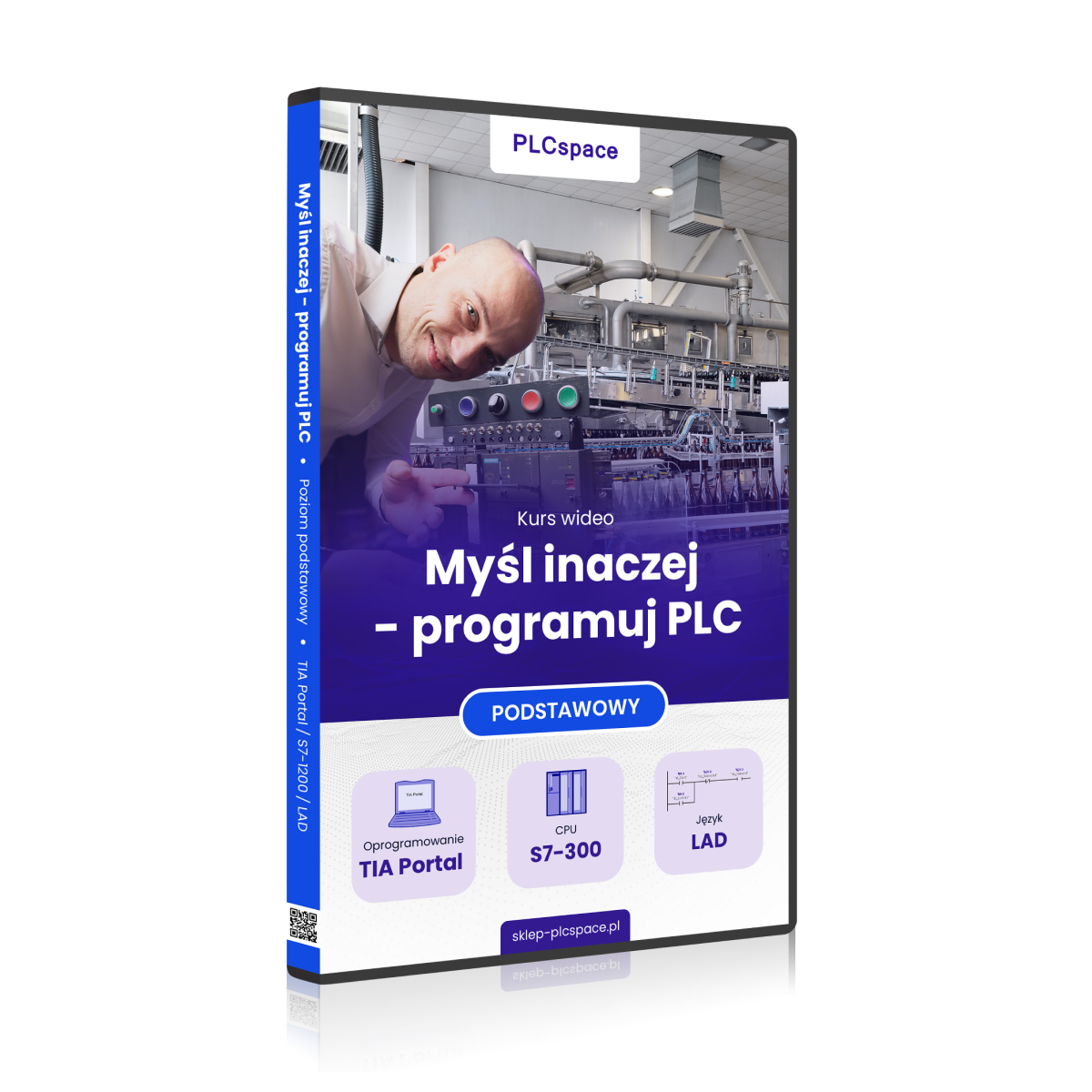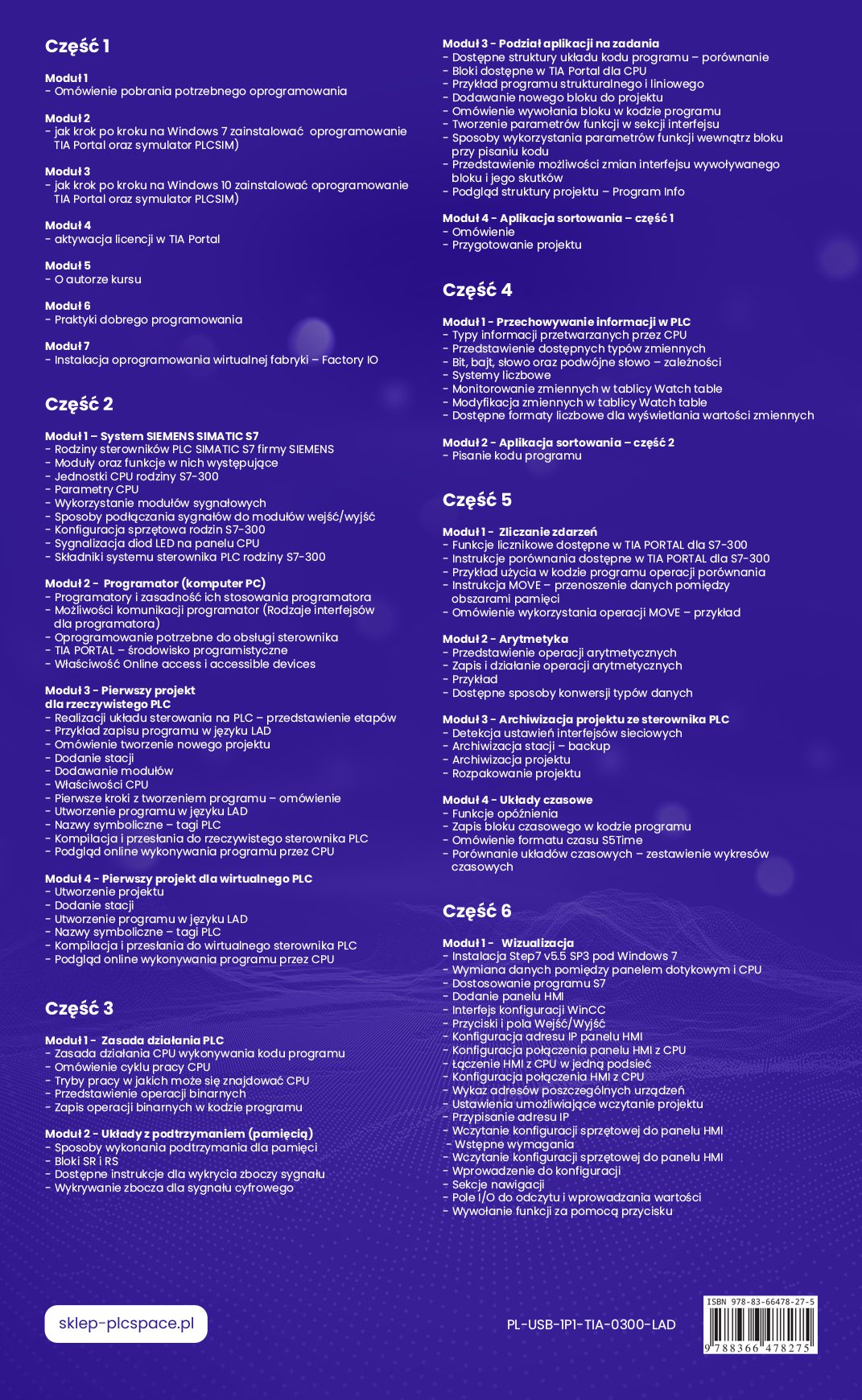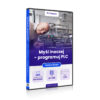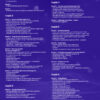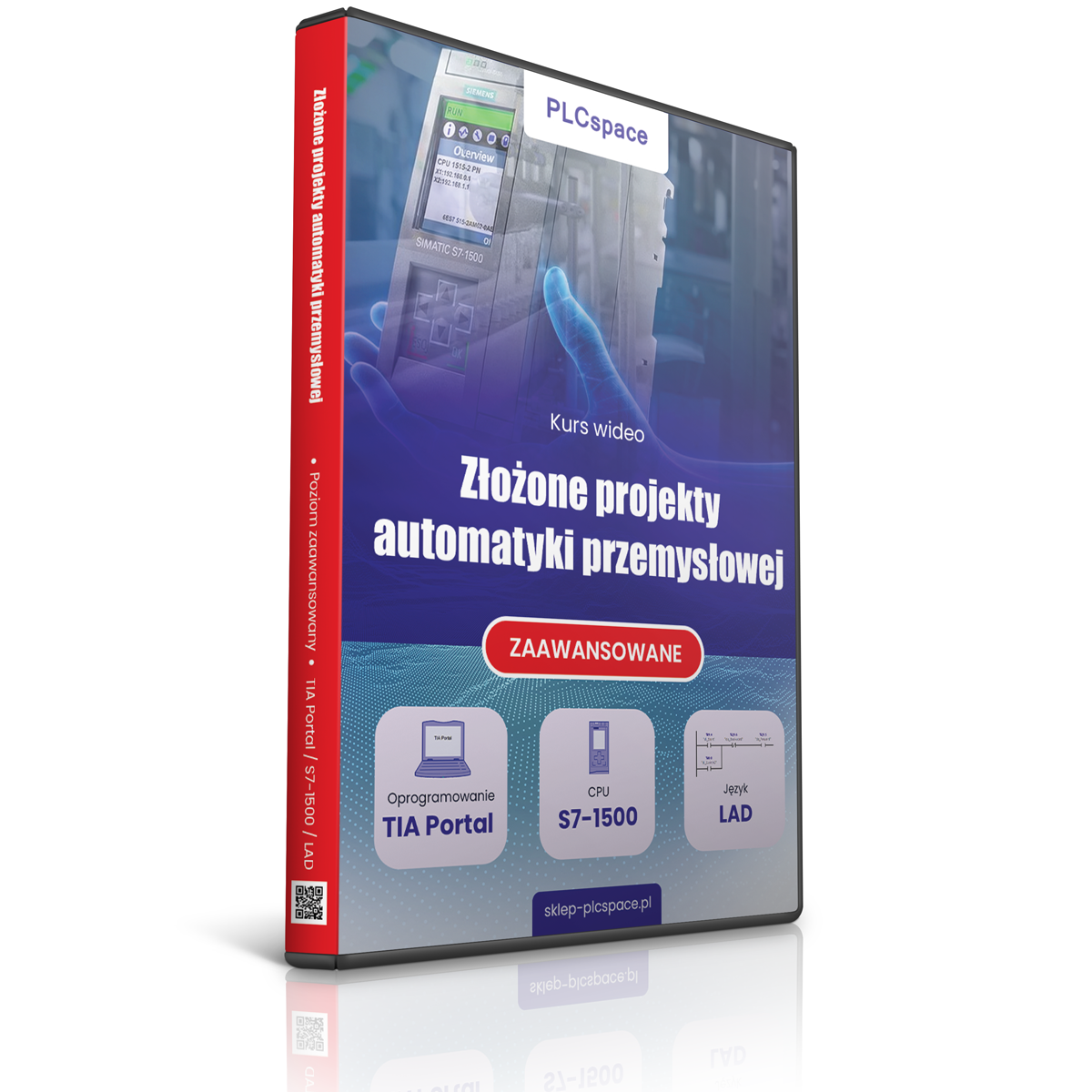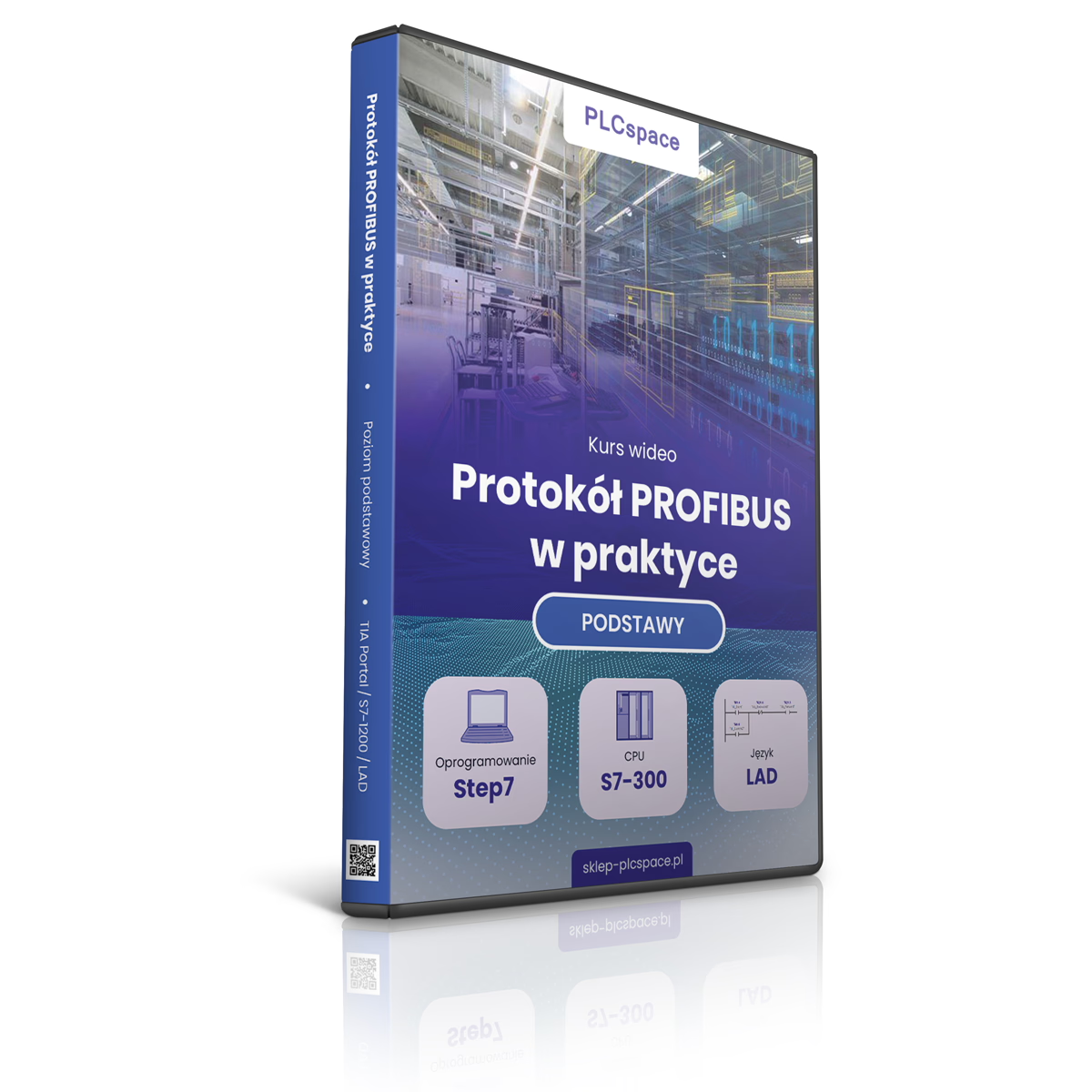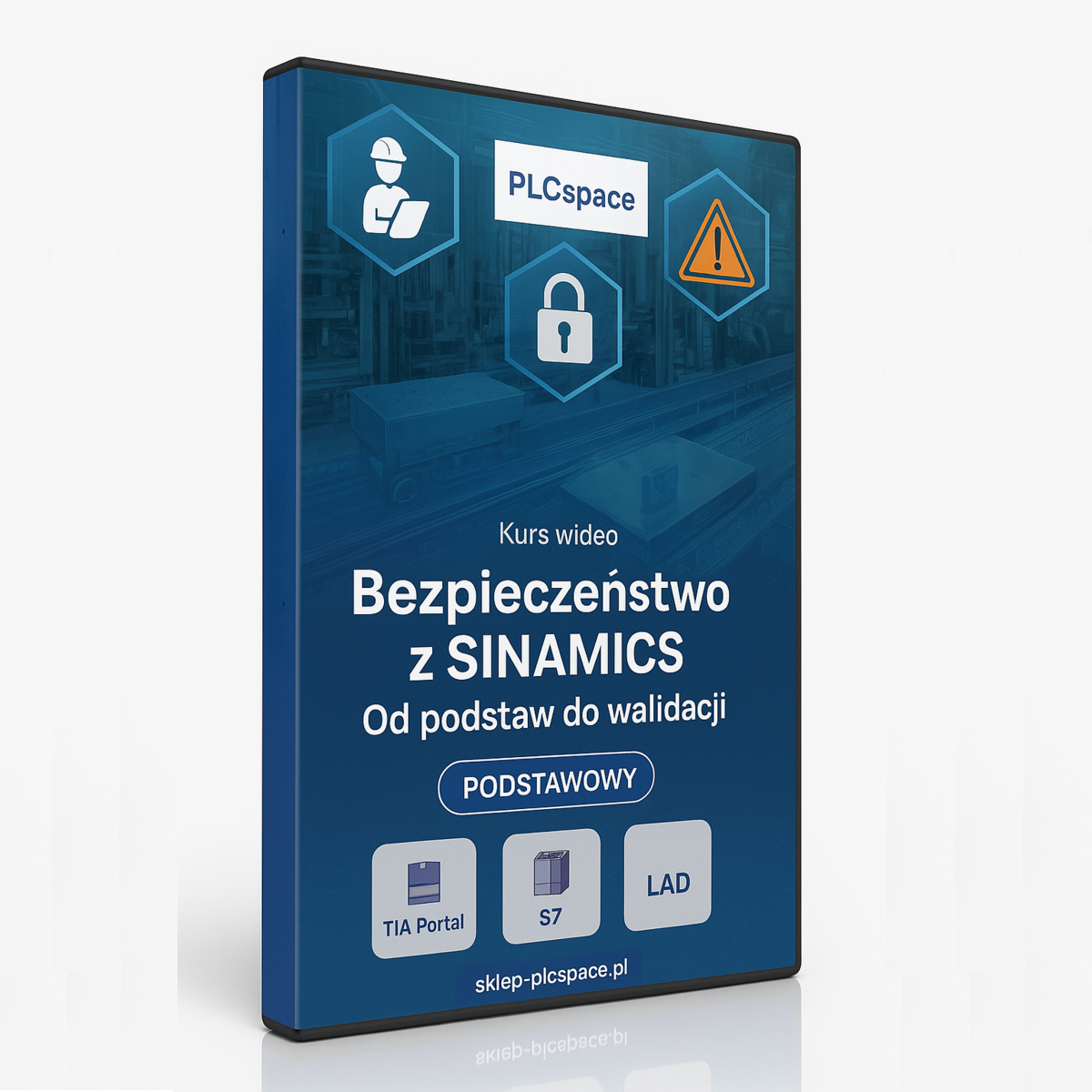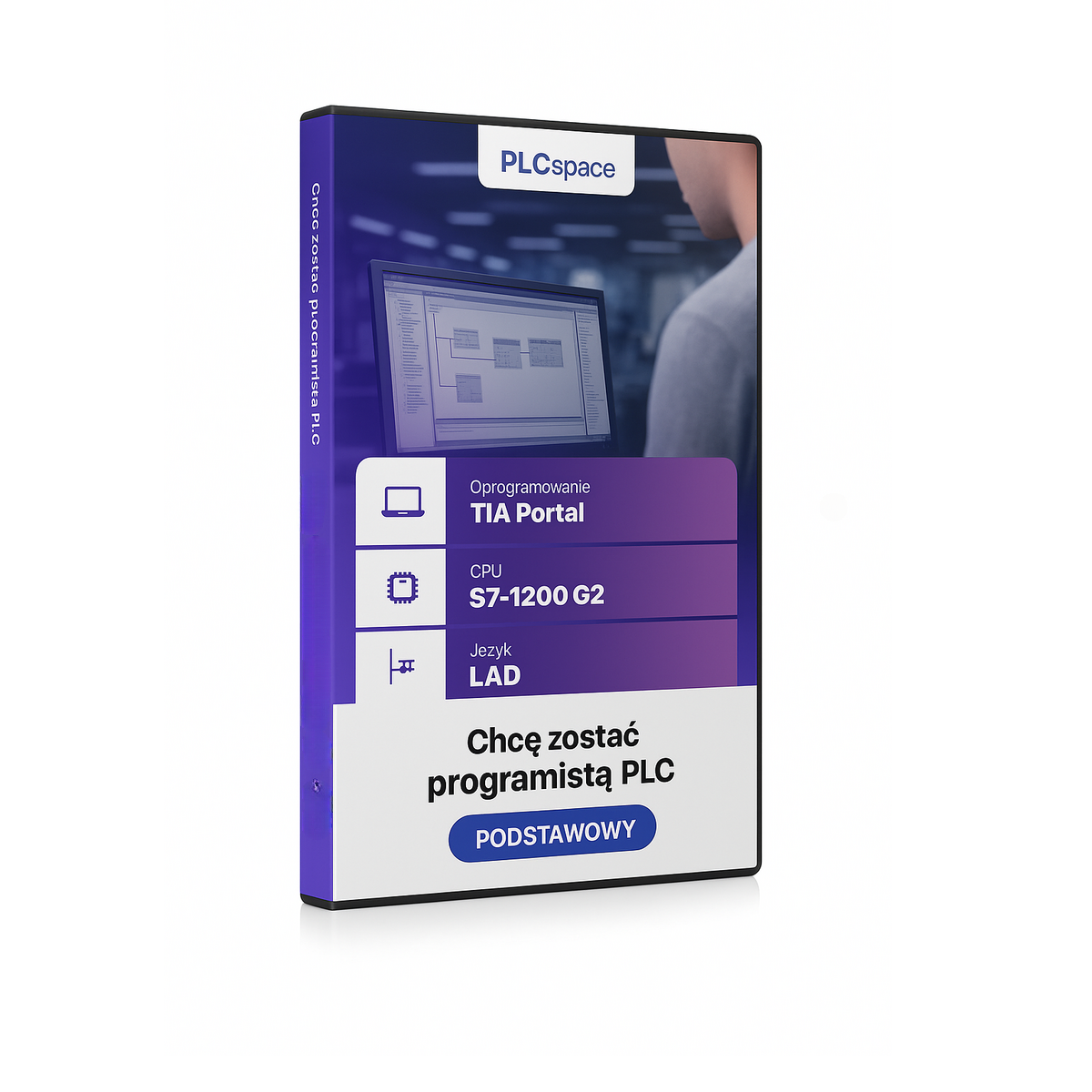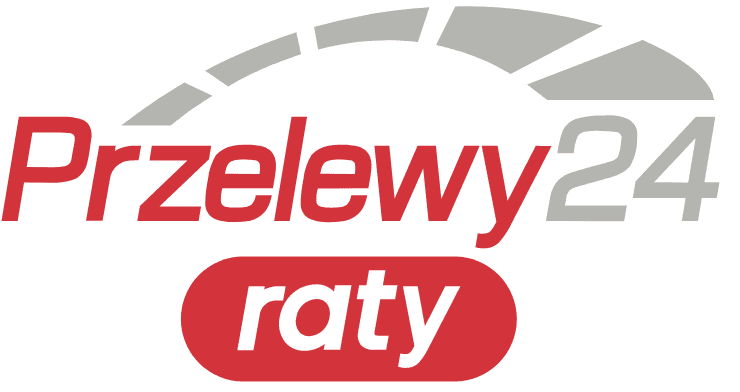Think differently - program the PLC
- Level:
The development environment used in the course
- Software:
Core unit family used in the course
- CPU:
A set of rules that are used to develop programme code
- Language:
Frequency converter (inverter) family used in the course
- Drive
399.00 zł
What do you get when you enrol on an industrial automation programming course?
Don't be afraid that you will be saddled with complex knowledge that will take you months to master. Nothing could be further from the truth! This course is designed to familiarise you with the basics of PLC. As part of the training, you will be provided with ready-to-use materials that you can refer back to whenever you feel the need to brush up on particular topics. We offer you:
Think differently - Program PLC. Siemens S7-300 PLC programming basics, entry level - TIA Portal
Siemens Simatic PLCs are a staple in any industry where machine automation is used. This course is dedicated to a particularly important module family - the Simatic S7-300. This is one of the most popular modules for stand-alone programming. It is distinguished by its high flexibility and modularity and is suitable for the design of stand-alone and distributed systems.
Our PLC course will enable you to master the basics of programming Siemens controllers, even if you have not dealt with them before. Siemens controllers from the S-300 family are so popular that you will find them in the automotive, machinery, food and chemical industries. They are used in building automation systems as well as process engineering and plastics processing. Siemens Simatic S7 is the future of modern automation!
If you have a technical background and dream of working as an automation engineer, but have never had to deal with Siemens Simatic PLC programming, you've come to the right place! After our PLC and HMI programming course, you'll surprise your employer with knowledge that you don't just get from reading academic textbooks.
What is the Simatic PLC programming course about?
The entire PLC training course is designed to explain to you the given topic from the very beginning to the intermediate level. The topics we cover during the training will be useful in any profession where you will come into contact with industrial programming. We have provided you with a large dose of theoretical and practical knowledge about the S7-300 CPU. Why this Siemens PLC family? The structure of the S7-300 controller stands out:
- access to Profibus and Profinet communication interfaces;
- an external MMC card and a maintenance-free CPU that does not require battery power;
- can be combined with Safety Integrated technology;
- SIPLUS technology, which provides resistance to low and high temperatures and harsh environmental conditions.
In combination with the TIA Portal software, it creates a very powerful programming environment. Programming the operation of the Siemens Simatic S7-300 controller is possible in LAD and SCL ladder language, but for programming training you will master the former. In practice, it is used in 90% situations and is extremely accessible to beginners.
The course is taught using the Sorting by Height (Advanced) application, which will take you into a virtual factory. You will prepare a simulator of a pallet product sorter against height.
Siemens S7-300 PLC programming is convenient as it does not require you to purchase any additional software or hardware.
You will be solving all your problems in the TIA Portal v. 15.1 environment, which is just for controlling Siemens modules. You can download it for free from the manufacturer's website and the software will retain full functionality for 21 days. This is far more than you need to complete the PLC basic course.
If you have an older or newer version of the TIA Portal environment, you will also be able to do this training. The course programme also includes learning to program on the PLCsim simulator, which replicates the operation of the S7-300 controller.
Find out that programming PLC logic controllers in the LAD language is not as difficult as it seems, and you can master it without paging through thick books. See what a great hands-on course looks like, after which you will get your dream job and increase your qualifications.
Knowledge test:
Is this course for you? Take this test MULTIPLE choice to check it out.
Key information about the course
Have you already checked the table of contents of our training? Be sure to do so! We offer you a wealth of knowledge ready to be put into practice, including many topics you have certainly never encountered before.
We want you to feel comfortable after our course as a professional who is part of a team. We will make you capable of finding your way in both a small group of individuals and a large company that relies on reliable and proven solutions.
Surely you have heard more than once that it is best to learn from other people's mistakes. This is true, but it's even better simply not to make them. We will show you how to avoid common mistakes and stumbling blocks.
Our course is the perfect combination of theory and practice. You can test all the solutions in the Factory I/O application, which simulates the operation of a real factory. Train now to show what you are capable of at work.
We are happy to share our knowledge and experience. Many years of practice and participation in large projects allow us to teach beginners effective PLC programming practices.
Gain knowledge of programming Simatic controllers. Find out why you should work with PLCSpace!
You will find many a Simatic machine automation and PLC tutorial on the market, but our training is a whole different level. What can a programming course look like that is easily accessible, understandable and based primarily on practice?
Sample lesson / What you will do after the course
What is the S7-300 PLC programming training course like?
Our Siemens Simatic S7-300 PLC training consists of 6 parts, each of which is dedicated to different blocks of topics. You will learn how to control PLC modules and use them in your daily work to improve the functioning of your project.
Once you have completed all parts, you will have a working knowledge of logic controller programming that you will use in your daily routines. You will find that you will watch our PLC programming course with curiosity and return to it again and again. Check out the courses on offer today!
-
Module 1
- Discussion of downloading the necessary software
-
Module 2
- How to install software step by step on Windows 7
TIA Portal and PLCSIM simulator)
- How to install software step by step on Windows 7
-
Module 3
- How to install software step by step on Windows 10
TIA Portal and PLCSIM simulator)
- How to install software step by step on Windows 10
-
Module 4
- licence activation in TIA Portal
-
Module 5
- About the course author
-
Module 6
- Practices of good programming
-
Module 7
- Installation of the virtual factory software - Factory IO
-
Module 1 - SIEMENS SIMATIC S7 system
- SIMATIC S7 PLC families from SIEMENS
- Modules and their functions
- CPUs of the S7-300 family
- CPU parameters
- Use of signal modules
- Ways of connecting signals to I/O modules
- Hardware configuration of the S7-300 families
- LED indication on the CPU panel
- System components of the S7-300 PLC family
-
Module 2 - Programmer (PC)
- Programmers and the rationale for their use
- Programmer communication capabilities (Interface types
for the programmer) - Software needed to operate the controller
- TIA PORTAL - Development environment
- Online access and accessible devices property
-
Module 3 - First project for a real PLC
- Realisation of the control system on a PLC - presentation of the stages
- Example of program writing in LAD language
- Discussing the creation of a new project
- Addition of stations
- Adding modules
- CPU characteristics
- First steps with programme development - overview
- Creation of a programme in the LAD language
- Symbolic names - PLC tags
- Compilation and transfer to the actual PLC
- Online preview of programme execution by CPU
-
Module 4 - First project for virtual PLC
- Creation of the project
- Addition of stations
- Creation of a programme in the LAD language
- Symbolic names - PLC tags
- Compilation and transfer to the virtual PLC
- Online preview of programme execution by CPU
-
Module 1 - PLC operating principle
- CPU principle of program code execution
- Overview of the CPU duty cycle
- Operating modes the CPU can be in
- Representation of binary operations
- Storage of binary operations in program code
-
Module 2 - Systems with backup (memory)
- Ways of implementing memory backup
- SR and RS blocks
- Available instructions for detecting signal edges
- Edge detection for digital signals
-
Module 3 - Dividing applications into tasks
- Available programme code layout structures - comparison
- Blocks available in the TIA Portal for the CPU
- Example of a structured and linear programme
- Adding a new block to the project
- Discussion of block calling in program code
- Creation of function parameters in the interface section
- Ways of using function parameters inside a block
when writing the code - Demonstration of the possibility of changing the call interface
the block and its effects - Project structure preview - Programme Info
-
Module 4 - Sorting application - Part 1
- Overview
- Project preparation
-
Module 1 - Storage of information in the PLC
- Types of information processed by the CPU
- Presentation of available variable types
- Bit, byte, word and double word - relationships
- Number systems
- Monitoring of variables in the Watch table
- Modification of variables in the Watch table
- Available number formats for the display of variable values
-
Module 2 - Sorting application - Part 2
- Writing programme code
-
Module 1 - Counting events
- Counting functions available in TIA PORTAL for S7-300
- Comparison instructions available in TIA PORTAL for S7-300
- Example of the use of comparison operations in programme code
- MOVE instruction - transferring data between
memory areas - Discussion of the use of MOVE operations - example
-
Module 2 - Arithmetic
- Representation of arithmetic operations
- Recording and operation of arithmetic operations
- Example
- Available data type conversions
-
Module 3 - Project archiving from the PLC
- Detection of network interface settings
- Station backup
- rchiving the project
- Unpacking the project
-
Module 4 - Timing systems
- Delay functions
- Recording of the time block in the programme code
- Overview of the S5Time time format
- Comparison of timelines - summary graphs
temporary
-
Module 1 - Visualisation
- Step7 v5.5 SP3 installation under Windows 7
- Data exchange between touch panel and CPU
- Adaptation of the S7 programme
- Addition of HMI
- WinCC configuration interface
- Buttons and input/output fields
- Configuring the IP address of the HMI
- Configuring the connection between the HMI and the CPU
- Combining the HMI and CPU into a single subnetwork
- Configuration of the HMI connection to the CPU
- List of addresses of individual devices
- Settings for loading the project
- IP address assignment
- Uploading the hardware configuration to the HMI
- Initial requirements
- Uploading the hardware configuration to the HMI
- Introduction to configuration
- Navigation sections
- I/O field for reading and entering values
- Calling a function using the button
Software and hardware used
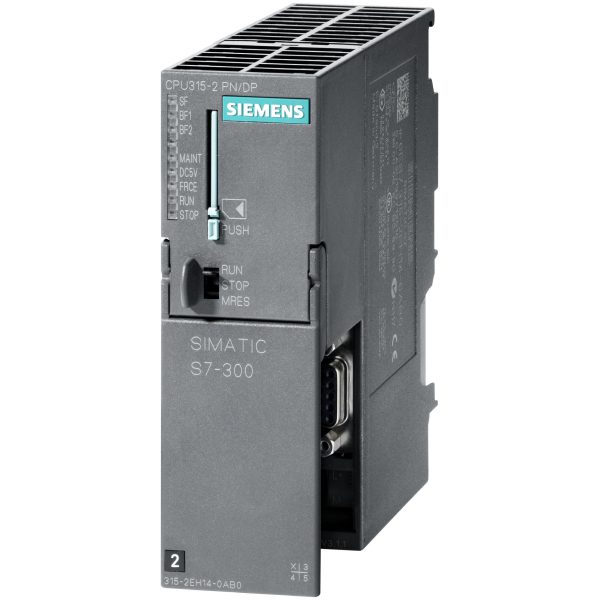
CPU S7-300
It comes in classic and et200s housing. it is currently the most popular and frequently used in industry. It can be seen in almost every industrial plant. It has the best performance-to-price ratio. It is very efficient, making it easy to carry out complex automation tasks,
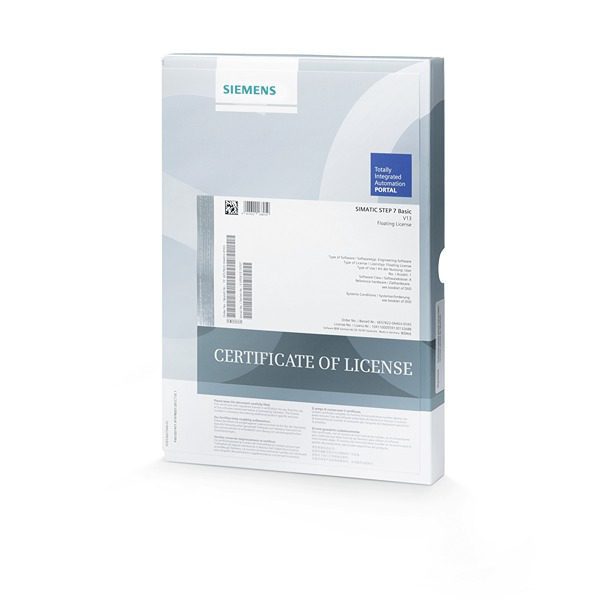
TIA Portal software
Totally integrated automation is a development environment that combines PLC (programming), HMI(visualisation) and startdrive(drive technology).
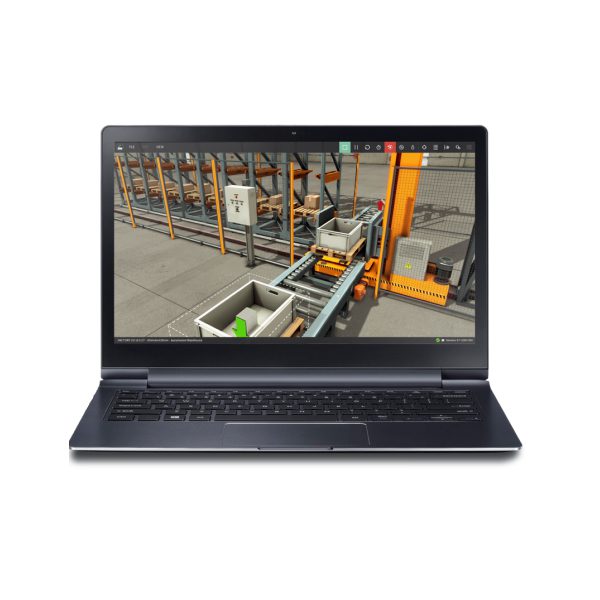
Factory IO
Typical machine scenarios can be run in Factory IO, and the virtual factory connects to the SIM PLC simulator (or the actual PLC. Programming of the controller is possible in the programming environment (depending on the PLC family), and insight into its operation is available during the online connection
What will you be able to do after completing the course?
After completing our course, you will find employment in a wide range of occupations. The knowledge you gain will enable you to choose from a wide range of vacancies. The following are just a few examples of the industries you can pursue.
What employers value is not so much raw theoretical knowledge, but how well you are able to apply it in practice. Our course focuses on just that - with the ready-made solutions we have prepared for you, you will find it much easier to navigate the job market than someone whose only asset is knowledge of dry, learned rules. Previous experience with programming is not necessary to become an expert!


Guarantee
and certificate
If, after 14 days of purchase, you find that it is not for you, I will refund 100% of the course price. Upon completion of the course, you will receive a certificate in two languages - Polish and English.

Frequently asked questions
-
Will I receive a confirmation after my purchase?
Yes, you receive an email. Sometimes emails end up in SPAM or other folders. Please check your mailbox carefully.
-
Is there a difference between the media on which the course can be ordered?
No. The material is the same regardless of the type of storage medium. At the time of purchase, you decide which type of data carrier you choose, i.e. online, DVD or USB.
-
Which PLC programming language should I choose when starting out?
If you are an electrician then LAD. If there has been any exposure to text-based languages (C, C++, C#, Java, etc) then SCL. If there has been no exposure to any programming at all then the basic course is LAD and SCL (the solution to each task is shown in two languages).
-
Is this course for me if I have never used a PLC?
Yes. The basic courses are just set up so that people with no exposure to Siemens PLCs can learn such skills. The student is guided step by step (as can also be seen in the course table of contents).
-
What tools are used for consultation?
Consultations take place via Skype or TeamViever.
-
How do I make an appointment for a consultation?
Please send an email to biuro@plcspace.pl with your questions (problems) and suggestions for a convenient date for your consultation (via Skype or Teamviever).
-
How long are the consultations valid?
This is 60 calendar days from the date of purchase.
-
Can I deliver the course on different computers?
Yes. The course material (videos) can be viewed on any computer.
-
What does the online version of the course look like?
You receive the course by email, where there are private links to the videos.
-
What if a problem arises during the course?
Please email me with a description of the problem at: biuro@plcspace.pl.
-
What is the access time for the course?
No time limits for any medium (i.e. online, DVD or USB version).
-
Do I need to have any experience with programming?
No. The basic course gives step-by-step all the information needed from 'scratch'.
-
Will I need to purchase a licence for the Factory IO software?
No. There is information in the course on how to obtain licences to complete the material.
-
Will I need to purchase a licence for the PLC development environment?
No. There is information in the course on how to obtain licences to complete the material.
-
Is it possible to return the course?
Yes.
-
Will I need a PLC to deliver the course?
No. A real controller is not necessary. The course is designed in such a way that it can also be completed on a virtual controller. It all depends on what the trainee has at their disposal.
-
How do I buy a course?
Just click Add to basket and complete the form and make payment.
-
When does the course start?
-> Online version - immediately after payment
-> Physical version - when you receive the package from the carrier.
Buy as a set and save
Select at least 2 courses from the list and the first free book item (three selections in total) and an automatic discount of 25% will be calculated in your basket.
If you want to find out more about a particular course, click on its name and the page will take you to its offerings.
Companies that have benefited from our courses




































Feedback from students
 Stanislaw
Stanislaw
What sets this course apart is the opportunity to acquire practical, concrete knowledge. Everything is clearly explained. Definitely recommended!
 Marcel
Marcel
After going through the course, I know what the components of the programming environment are and what to do step by step. Now I feel confident and know what I am doing
 Leon
Leon
Course delivered in a very accessible way. Contains a lot of interesting and useful information.
 Michael
Michael
I can honestly recommend the course. It is solid and factual knowledge. I will definitely be buying more.
 Victor
Victor
Thanks to the course, I have decided to go further in this direction. The goal is to look for a more challenging and better job
 Peter
Peter
The course prepared by Mr Tomasz is distinguished by its high level of content and meticulously prepared lessons. They are planned in a clear and sensible manner, making it easier to assimilate knowledge and return to the material if necessary. An additional advantage is the possibility of a free consultation.
 Nikodem
Nikodem
Definitely recommended! The facts themselves, no unnecessary dwelling on issues.
 Ignatius
Ignatius
This is my first course, certainly not my last. I am impressed with the substantive quality of the knowledge.
 Tymon
Tymon
Everything clearly explained, you can really learn a lot. Lots of practical information and examples to help you remember everything. In my opinion, it is worth using this form of learning because you can learn anytime and anywhere. It is practical and convenient.
You may also be interested in:
- Level:
The development environment used in the course
- Software:
Core unit family used in the course
- CPU:
A set of rules that are used to develop programme code
- Language:
Frequency converter (inverter) family used in the course
- Drive
1.199.00 zł
- Level:
The development environment used in the course
- Software:
Core unit family used in the course
- CPU:
A set of rules that are used to develop programme code
- Language:
Frequency converter (inverter) family used in the course
- Drive
999.00 zł
- Level:
The development environment used in the course
- Software:
Core unit family used in the course
- CPU:
A set of rules that are used to develop programme code
- Language:
Frequency converter (inverter) family used in the course
- Drive
999.00 zł
- Level:
The development environment used in the course
- Software:
Core unit family used in the course
- CPU:
A set of rules that are used to develop programme code
- Language:
Frequency converter (inverter) family used in the course
- Drive
1.199.00 zł
